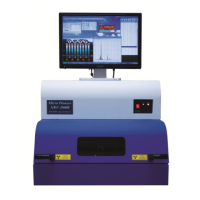XRF-2000 Series Operating Manual
71
Appendix
A. X-RAY FLUORESCENCE (XRF)
When a primary x-ray excitation source from an x-ray tube or a radioactive
source strikes a sample, the x-ray can either be absorbed by the atom or
scattered through the material. The process in which an x-ray is absorbed by the
atom by transferring all of its energy to an innermost electron is called the
“photoelectric effect.” During this process, if the primary x-ray had sufficient
energy, electrons are ejected from the inner shells, creating vacancies. These
vacancies present an unstable condition for the atom.
As the atom returns to its stable condition, electrons from the outer shells are
transferred to the inner shells and in the process giving off a characteristic x-ray
whose energy is the difference between the two binding energies of the
corresponding shells. The emitted x-rays produced from this process are called
“X-ray Fluorescence,” or XRF. The process of detecting and analyzing the
emitted x-rays is called “X-ray Fluorescence Analysis.” In most cases the
innermost K and L shells are involved in XRF detection.
A typical x-ray spectrum from an irradiated sample will display multiple peaks of
different intensities.
The characteristic x-rays are labeled as K, L, M or N to denote the shells they
originated from.
Another designation alpha (α), beta (β) or gamma (γ) is made to mark the x-rays
that originated from the transitions of electrons from higher shells. Hence, a Kα
x-ray is produced from a transition of an electron from the L to the K shell, and a
Kβ x-ray is produced from a transition of an electron from the M to a K shell, etc.
Since within the shells there are multiple orbits of higher and lower binding
energy electrons, a further designation is made as α1, α2 or β1, β2, etc. to
denote transitions of electrons from these orbits into the same lower shell.
The XRF method is widely used to measure the elemental composition of
materials. Since this method is fast and non-destructive to the sample, it is the
method of choice for field applications and industrial production for control of
materials. Depending on the application, XRF can be produced by using not only
x-rays but also other primary excitation sources like alpha particles, protons or
high energy electron beams.
Sometimes, as the atom returns to its stable condition, instead of emitting a
characteristic x-ray it transfers the excitation energy directly to one of the outer
electrons, causing it to be ejected from the atom. The ejected electron is called
an “Auger” electron. This process is a competing process to the XRF. Auger
electrons are more probable in the low Z elements than in the high Z elements.

